 |
|
|
|

In the orientation phase, students select a topic of study that interests them and familiarize themselves with the instruments they'll need to collect data.
On this Voyage of Discovery, the students organized into six teams of two, each focusing on a specific field of study. In turn, each pair of students would work closely with an individual senior crew advisor.
Starting right on Day One and working through Day Three, the students spent their time learning about each possible topic and using all of our intruments. Although the students' individual projects would be tightly focused, each student would also learn how to perform every experiment, including several which are not currently part of anyone's research projects.
Since learning to use our scientific gear is a central part of the orientation phase, the photos below illustrate our student crew members taking readings for the Deck Log rather than focusing on the topics of their own projects.
You can scroll down or use the links below to jump directly to a topic.
|
|
Comparative Temperatures
|
| 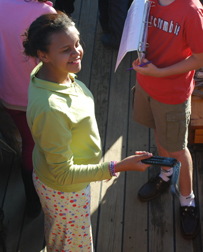 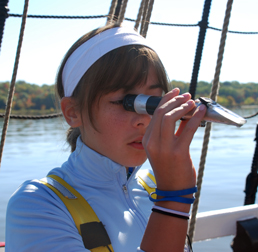
Students: Christina & Evi
Hypothesis: We believe that the water temperature will always be a few degrees colder than the air.
During the ship's data layover in New York Harbor, Christina and Evi will track ambient air temperatures and surface water temperatures over the course of a full 24 hours, seeking to determine whether there exists any correlation between them.
|
Back to Top
|
|
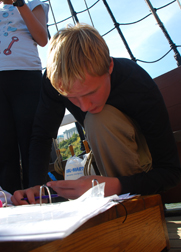 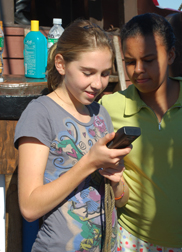
Students: Andrew & Lizzie
Hypothesis: Since the Sun rises in the east and sets in the west, then at the Sun's highest point its bearing must be due south.
While the Half Moon remains at anchor in New York Harbor, Andrew and Lizzie will use celestial tracking techniques to chart the course of the Sun as it transects the sky, seeking to determine the actual time of true local noon. Having determined local noon, they will also be able to determine true south.
|
|
Tidal Patterns
|
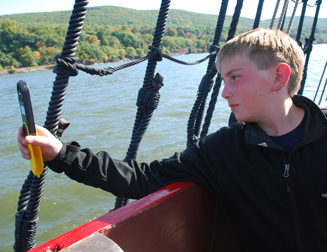 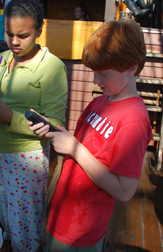
Students: Greg & Ross
Hypothesis: The current will go fastest during the ebb tide.
Like Andrew and Lizzie, Greg and Ross initially chose to focus on celestial tracking for their presentation, tracking the transect of the Moon during our data layover at Grave's End Bay. However, an overcast night interfered with this plan, prompting them to switch topics.
Instead, Greg and Ross will measure current speed and sound the water's depth at a fixed location over the course of a tidal cycle, using their readings to determine local tidal patterns.
|
Back to Top
|
Relative Humidity |
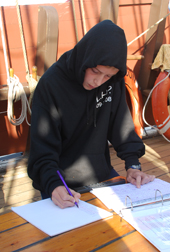 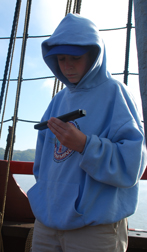
Students: Luke & Peter
Hypothesis: When the air temperature drops the relative humidity will increase.
During the Half Moon's data layover, Luke and Peter will use a sling psychrometer to record changes in relative humidity levels over the course of a full 24-hour period. Inspired by a particularly dew-heavy night on board, they will particularly focus on nocturnal temperature changes.
|
Back to Top
|
Salinity |
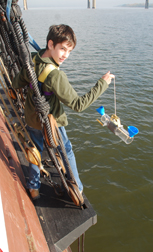 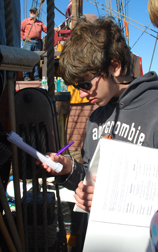
Students: Bennett & Jonathan
Hypothesis: Salinity levels will increase as we approach the ocean.
While the Half Moon remains anchored in Grave's End Bay, Bennett and Jonathan will test salinity in the water column. They will also analyze all of the water samples collected by the crew since first detecting the presence of salinity at Newburgh.
|
|
Mechanical Advantage
|
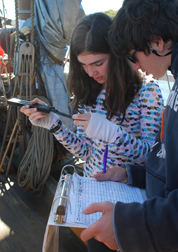 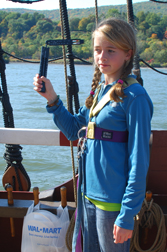
Students: Jena & Natalie
Hypothesis: If we lift up Mr. Chase about two feet high using blocks and rope then we can use the effort required to determine his weight.
Jena and Natalie initially chose to study turbidity during a tidal cycle during the ship's data collection layover, but their static readings prompted them to change topics.
Instead, they will study the use of mechanical advantage on board the Half Moon. During the ship's layover, they will construct a simple machine to lift a lead ingot, and will determine how the block-and-tackle components of their rig affect the force needed to lift a given weight.
|
|
|
|
|
|
|
|
|

